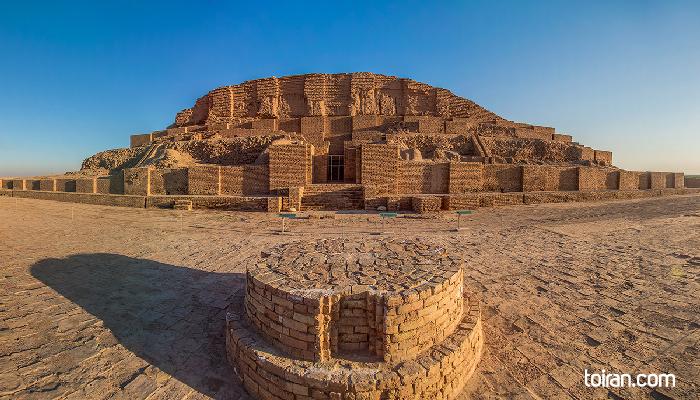Chogha Zanbil is a five-level Ziggurat located approximately 40 kilometers southeast of Sush cityin Khuzestan Province. This mud brick ziggurat was built by Elamite King Untash-Napirisha (1240 -1275 BC) who wanted to create his religious and political capital around it.
Ziggurats were temples built in receding tiers upon rectangular, oval, or square platforms. These pyramidal structures had sun-baked brick cores and multicolored glazed-brick exteriors. The number of tiers ranged from two to seven, with a shrine or temple at the summit. Experts believe the seven levels of the ziggurat represented the number of heavens, planes of existence, planets and the seven metals and the colors associated with them.
Considered the temporal dwelling of a deity or the meeting place of gods and humans, ziggurats had a high temple, a low temple and no internal chambers. They were not used as places for performing public religious rites and rituals, but rather as the earthly house of God.
Priests were the only ones allowed inside the temples of the ziggurat. They were tasked with attending to the needs of the gods. The temple at the base of the ziggurat was where the deity inhabiting it was fed and clothed daily. Access to the shrine at the top of the ziggurat was either possible via exterior stairways, a series of ramps on one side of the ziggurat, or a spiral ramp from base to summit.
The ziggurat also had sacred workshops, granaries, storehouses, kitchens, and rooms for priests and slaves, who were employed in smelting, weaving, and preparing goods for sale. Ziggurats also had kilns in which the inscribed glazed tiles used in their decoration were prepared.
This Chogha Zanbil (basket mound) temple complex, which was originally named Dur Untash (town of Untash), was dedicated to Inshushinak, the bull-god of Susa. Untash-Napirisha had planned to build more temples in the city but died before completing his plans and his successors abandoned the project. The town continued to be occupied by priests and servants until the Assyrian king Ashurbanipal (685-627 BC) destroyed it in 640 BC.
Chogha Zanbilis is made from mud brick and is decorated with glazed baked bricks bearing Elamite inscriptions and colored glass. The ziggurat was once 53-meter-tall but today only two of its levels, or 25 meters of it stand.
One of the best preserved ziggurats still standing today, Chogha Zanbil was inscribed as a UNESCO World Heritage Site in 1979.





